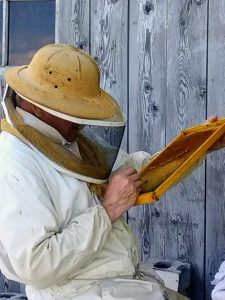Click Here if you listened. We’d love to know what you think. There is even a spot for feedback!
Read along below!
Off the Wahl Beekeeping
New(ish) Beekeeper Column
Feeding Your Bees
By: Richard Wahl
Background
For the past two years I have been a partner mentor with four or five other beekeepers that have provided on-site, hands-on instruction to beginning or potential beekeepers. The new beekeepers are encouraged to maintain one hive at either of two participating farm locations through the ten month course. For more than thirty years, the Southeast Michigan Beekeepers Association (SEMBA) has managed this bee school which can concurrently handle up to thirty students at each location. Throughout the duration of the course, which meets on average once a month, one of the more frequently asked questions is related to, “When, what and how often do we need to feed our bees?”
Feeding bees some form of granulated sugar might seem counterproductive to the new beekeeper. In other words, why spend money on a food source for the bees that are supposed to be producing that food source, honey? Consider the fact that while granulated sugar can be purchased for around 70 cents a pound, or less if in larger quantities, you can often sell honey for more than $8.00 a pound. So when there is a dearth, the lack of a nectar flow, or a long, hard Winter, it may be wise to feed the bees during those “emergency” times to keep your bees healthy and at their productive peak.
As with most things in beekeeping, there is not one specific answer to the question about feeding bees. While feeding bees may seem controversial for some, there are times when feeding may be the last resort to save an otherwise starving hive. I will endeavor to provide some ideas and options that have worked for me over the past fifteen years as well as to offer some suggestions that I know are used by other area beekeepers.
Winter Feeding
There are several reasons when feeding prior to or through the Winter may be required. If strong hives enter the Winter season with a heavy population of bees there might not be an adequate supply of stored honey to get them through the Winter. This may be due to the beekeeper taking too much honey from the hive, a late Summer collection of a swarm, a poor nectar flow in the Fall or if the hive went through a robbing event. In any of these cases, heavy population, robbing or a dearth due to weather variations, feeding may be just enough to get that hive through to the next season. I like to wait until just before, during or after the Christmas holidays to add a granulated sugar feeder to my hives on one of those infrequent warm, sunny Winter days.
I wait until around the holidays to add that type of feeder to my hives since the sugar in its refined state is harder for the bees to digest than a syrup solution. If cane sugar is added too soon in the Fall and the bees take a liking to it sooner than expected, it can cause a dysentery outbreak among the bees. This is evidenced by streaks of orange-brown bee poop all over the outside of the hive and particularly near any entrances. A nosema outbreak will also show these characteristic orange-brown streaks but will be accompanied by bee’s inability to fly with many dead or dying bees near hive entrances and a lot of bee poop on inside combs and frames.
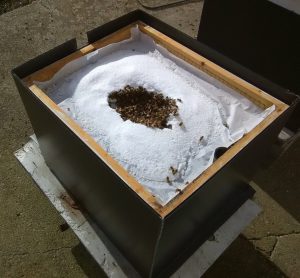
Baking parchment paper over ½ inch wire mesh with Winter feeder set above top deep frames. Note how bees work from one chewed through area.
My sugar feeder consists of a half inch wire mesh (called hardware cloth) with one inch bent up sides stapled to a three inch spacer frame, the same size as my deeps, with the wire about ¼ inch above the bottom edge of the frame. The ¼ inch space leaves enough room for the bees to move around on the top of frames just below the feeder wire which holds a sheet of baking parchment paper also folded up about an inch on each side. I have found that the waxed cookie sheet baking paper is just a bit harder for the bees to chew through than newspaper. A knife slit in several places gives the bees a chew through starting point. With newspaper the bees chew most of it very quickly and much of the sugar falls through to the frames and bottom of the hive and goes unused.
Since bees tend to move upward as they go through their honey stores, there is much less waste if the sugar can be contained above. The sugar above also serves as a moisture absorbent and collects much of the condensation that would otherwise drip down on the bees. If there is still sugar left when I do my first thorough hive inspection of all the frames, just after the first Spring dandelion heavy bloom, I collect any remaining sugar clumps and store them in a five gallon covered pail to reuse next season. A frame of this size will easily hold four to five pounds of sugar poured onto the waxed baking parchment paper.
It took me four or five years to move to the granulated sugar Winter feeding as before that I was making hard candy boards. A candy board looks like an inverted telescoping outer cover that measures the same size as the hive super which eliminates the overlapped telescoping. In the center, a piece of 2×4 is glued with a two inch hole through the 2×4 and the candy board floor. This hole serves as an air vent while the 2×4 serves as a raised area so the candied sugar will not run out when poured while in its liquid phase. A water tight glue is used to hold everything together. I spent a few minutes with the candy board filled with water to be sure there are no leaks before removing the water and pouring in the candied sugar solution.
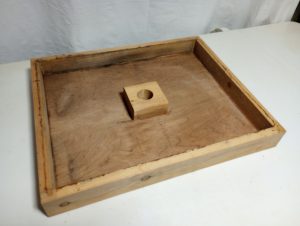
An empty hard candy board feeder.
On my first attempt using this method, I brought about five pounds of sugar in a cup of water to a rolling boil in a too small ten quart pot. Since the constantly stirred rolling boil needs to reach a temperature of around 250°F (121°C) in my area (temperature depends on your land elevation), I could not reach that temperature without the sugar slurry bubbling over the top of the pot. I had to call for my wife’s help to pour half the mix into another pot which she continued to heat and stir as my half of the cloudy mix became clear when reaching the desired hard candy temperature. At that point it was allowed to cool to between 180° and 200° and then was poured into the candy board. My wife’s half in the second pot soon reached the desired temp and was also poured into the candy board. After letting it cool and solidify over night the candy board was placed on a hive (with candy side down). The first year I used this, I did not get the candy board on my double deep hive until mid-February. By the time dandelions were out in force, signaling time for a full Spring inspection, the bees had licked the hard candy board over a ten frame deep spotless and completely clean. I think it is obvious why using the granulated sugar is much easier than the hard candy method which requires the cooking stage.
Another method used by some beekeepers is to add just enough water to sugar to make it stick together and harden in a mold. A typical recipe for this is five pounds of sugar mixed with a cup of water. A small portion of powdered bee feed can also be added to this mix to supplement any protein needs. It is not uncommon to see recipes call for a tablespoon of vinegar added as a preservative to preclude spoilage or molding. There are various recipes suggested by reputable bee sources on the internet.
I know of some beekeepers who also like to use fondant as a supplemental food source. It is believed that fondant is softer and easier for the bees to digest as the sucrose sugar turned into fondant has already been broken down into the more basic glucose and fructose components closer to being like the flower nectars. Making bee fondant out of sugar requires some cooking steps. Once again, various recipes can be found online under making fondant for bees. If store bought fondant is used, be sure it consists only of cane sugar or corn syrup and does not have extraneous additives as those additives can be detrimental to the bees.
In the case of dampened sugar molds or fondant made into patties for bees, some type of spacer will be needed to provide enough room for those patties or sugar cakes to rest on the top of the frames below the inner cover without blocking the inner cover center vent hole. Pick whichever method you are most comfortable with and feed your bees to get through the Winter. I have found that bees only resort to these added supplements if their own honey stores have been exhausted or are unreachable as the bees move upward through their hives. A most disappointing Spring inspection is to find dead bees with their heads stuck in empty comb cells and find that the hive has starved.
Spring Feeding
I have a dozen full grown maple trees in my yard and there is one that is always first to have its buds pop open. On a warm, sunny day, usually the first week in March, standing under that tree is like being in the middle of a beehive. To the uninitiated, the buzz of the bees collecting nectar can be disturbing. I use this signal as a time to check my Winter sugar feeders and to add more sugar if needed and also a pollen patty to the feeders. This is when the queen is beginning to lay more eggs and the hive is coming alive for the following Summer. It is also the time when there will be few other pollen or nectar sources until the heavier dandelion bloom which occurs around the last week in April or first week of May, nearly two months later.
This period is when bees are most likely to starve if there are not enough honey stores or food supplements provided by me, the beekeeper. What I usually find is that ⅓ of my hives have totally used up the Winter sugar supply. An additional ⅓ will have partially consumed the sugar, while the remaining ⅓ will not have touched the supplemental sugar. The same seems to be true with the pollen patties, but not necessarily matching the use of the cane sugar. This could be the result of some hives having an adequate supply of pollen and/or stored honey or possibly a greater number or more efficient group of bees collecting the early available pollen and/or having a greater amount of stored honey.
Once the dandelions are in full bloom, when I complete my first deep hive inspections, I remove any remaining supplemental sugar which is now often in clumps due to its moisture absorption through the Winter. Any unused pollen patties are also removed, but if bees are using them, they are transferred to the tops of the frames. Use of the baking parchment paper allows me to collect and store unused sugar in a covered, five gallon bucket until next season.
Only if there is a dearth occurring will I supplement hives with sugar syrup. A dearth occurs when there is more than two to three weeks of no rain. After two or three weeks, the plants may be producing flowers, but they are not producing much nectar or pollen as they are supporting new growth, root development and nectar or pollen production is the first thing to be curtailed. If I decide to split a hive and the split has limited honey or pollen stores I will provide the hive with a sugar syrup mix and a partial pollen patty.
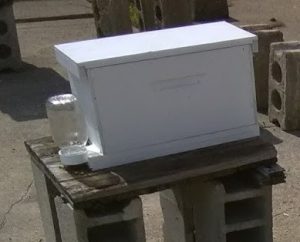
A quart jar Boardman feeder.
In the Spring, a one to one parts water to sugar is recommended. The one to one mix by volume most nearly equates to the nectar the bees would otherwise be collecting from flowers. I use a funnel to pour four to eight cups of sugar in a rinsed out plastic milk jug then add the same amount of warm water. A good shake of the capped jug three or four times at ten to fifteen minute intervals is enough to dissolve the sugar which can then be poured into any type of feeder the beekeeper prefers. I like to use the black frame feeders with any ten frame deep splits and the quart jar Boardman feeders on any five frame nucleus (nuc) splits.
Bees in a split with several frames of soon to emerge brood can easily consume the gallon frame feeder or quart jar feeder in a week if there is no external nectar flow going on. If there is a nectar flow the bees will normally collect from nature instead of using the supplied sugar syrup.
Summer Feeding
For Summer feeding of captured swarms, full size or five frame nuc splits, I use the same sugar syrup mix as for Spring feeding. If there is a concern for spoilage or mold, most recommendations I have read say to add a tablespoon of vinegar per gallon of mix. Exact proportions are not critical for the sugar syrup mix, but should be relatively close. A few days prior to placing honey supers on the hive, any feeders should have been removed. This precludes bees moving any sugar syrup stores into the honey supers. You want the honey that is collected to be made from nectar sources and not from the sugar syrup you have provided. If there is a good nectar flow on, I like to add two honey supers for the bees to work in. When there are only one or two partial or empty frames left that are not being used in the top or single deep for brood or nectar storage or in a nearly filled honey super, it is time to add the next honey super.
Fall Feeding

The black frame feeder holds one gallon and replaces one deep frame. Wood discs float in each feeder hole to avoid bees drowning.
In our area of southeast Michigan, the bloom of the Fall purple aster and goldenrod comes to an end sometime in late September or early October, depending on the weather. This occurs just as the first nightly frosts begin and is my signal to consider Fall feeding. If there has been a Fall dearth as a result of a dry spell, I may begin feeding the Fall sugar syrup mix in a two parts sugar to one part water ratio a bit sooner. The heavier sugar to water ratio provides a greater sucrose content and requires less effort by the bees to remove excess water.
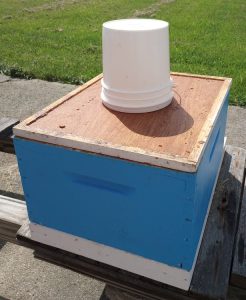
A bucket feeder on top of inner cover that will be surrounded by an empty super with an outer cover on top.
If it has been a wet Fall, knowing the Fall flowers are providing adequate nectar, I may wait a bit longer before putting on feeders. For the Fall season, I like the gallon or half gallon buckets that have a small screened hole in the top set inverted over the inner cover hole. When flipping the bucket to inverted, do not do so over the hive as there will be a small amount of seepage from the screened hole in the cover until a vacuum has formed in the bucket, and be sure the cover is on securely. Surround this with an empty super with the standard outer cover and only the bees in the hive can get to the feeder.
More often than not I will be removing emptied honey supers from on top of inner covers that I had previously placed there for the bees to clean out. In most cases the hive bees will clean out emptied honey supers placed in this manner as they are not perceived to be a part of the hive. In the event bees do start replacing nectar in a honey super simply move it to a different hive for cleanout.
Once temperatures consistently fall below freezing at night, it is time to stop with sugar syrup and wait to determine when to place Winter feeders on the hives, which brings us full circle to the beginning of this article. Like most things in beekeeping, feeding is not an exact science. The one thing I can say is that feeding has saved some of my hives during our variable Michigan Winters, while early in my beekeeping experience a lack of feeding had, on occasion, resulted in a hive sadly starving. Keep good notes and adjust your feeding regimen to your needs. Feed judiciously as needed and it will become a crucial step in becoming a sustainable beekeeper.




